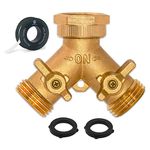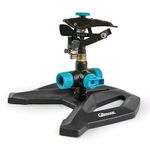Hi GPODers!
Today we’re venturing to a part of the US we don’t get to see very often on the blog (If you’re from this area and lurking on GPOD, please send in some photos of your gardens!). We’re heading to Weslaco, Texas to see the pollinator and wildlife haven that is Lisa Kay Adam’s garden.
For the last four years, I’ve lived in a cottage in a 55+ community near the very southern border of Texas (zone 10a). I have a small patio of container plants and three garden beds around my 850 sq. ft. house. I use my training as a Texas Master Naturalist to help me select plants that look good, survive our brutal summers, and serve wildlife. Even in my limited space, I’ve identified over three dozen species of animals directly using my plants for food or shelter.
This long bed filled with just a few species is where most of the action is. Despite its small blooms, the row of tall turk’s cap (Malvaviscus arboreus var. drummondii, Zones 7–11) is a hummingbird buffet, both for migrating ruby-throated hummers and our year-round buff-bellied species. Turk’s cap also provides fruit for mockingbirds and kiskadees, and serves as a butterfly host plant. Mounding orange zexmenia (Wedelia acapulcensis var. hispida, Zones 8–11) serve as host and nectar plants, and lesser goldfinch gobble their seeds. In the corner, American beautyberry (Callicarpa americana, Zones 6–10) and (not visible) a native Chile pequin (Capsicum annuum, Zones 9–11) give additional fruit for birds. Interspersed red yucca (Hesperaloe parvilfora, Zones 6–11) provide nectar during blooming.
 A fountain and bird feeder, as well as the live oak (Quercus virginiana, Zones 8–10) in a shared courtyard, draw additional species. (I don’t recommend the granite mulch, by the way—in this area it raises the temperature too much and doesn’t add nutrients to the soil—but it is required by my community.)
A fountain and bird feeder, as well as the live oak (Quercus virginiana, Zones 8–10) in a shared courtyard, draw additional species. (I don’t recommend the granite mulch, by the way—in this area it raises the temperature too much and doesn’t add nutrients to the soil—but it is required by my community.)
 It wouldn’t be Texas without a Texas “sage” or cenizo (Leucophyllum frutescens, Zones 8–10), which is also a host plant for the Theona checkerspot. Also featured in this photo are a young Rio Grande barrel cactus (Ferocactus hamatacanthus var. sinuata, Zones 7–10), pale leaf yucca (Yucca pallida, Zones 6–10) frogfruit (Phyda nodiflora, Zones 7–11), and a cultivar of Lantana camara. I added the frogfruit ground cover as a host plant for the white peacock butterflies I frequently saw nectaring at the lantana.
It wouldn’t be Texas without a Texas “sage” or cenizo (Leucophyllum frutescens, Zones 8–10), which is also a host plant for the Theona checkerspot. Also featured in this photo are a young Rio Grande barrel cactus (Ferocactus hamatacanthus var. sinuata, Zones 7–10), pale leaf yucca (Yucca pallida, Zones 6–10) frogfruit (Phyda nodiflora, Zones 7–11), and a cultivar of Lantana camara. I added the frogfruit ground cover as a host plant for the white peacock butterflies I frequently saw nectaring at the lantana.
 Many of our native species have small leaves and flowers as an adaptation to reduce moisture loss. This heartleaf hibiscus (Hibiscus martianus, Zones 8–10) still puts on a show in part shade with its 2 inch blooms.
Many of our native species have small leaves and flowers as an adaptation to reduce moisture loss. This heartleaf hibiscus (Hibiscus martianus, Zones 8–10) still puts on a show in part shade with its 2 inch blooms.
 I prefer to use native plants, but I sometimes grow species slightly out of my range, north or south. Hummingbirds and carpenter bees both love the tubular blooms peeking out of red bracts on the Mexican shrimp plant (Justicia brandegeeana, Zones 9–11).
I prefer to use native plants, but I sometimes grow species slightly out of my range, north or south. Hummingbirds and carpenter bees both love the tubular blooms peeking out of red bracts on the Mexican shrimp plant (Justicia brandegeeana, Zones 9–11).
 Queen butterflies flock to the nectar of Gregg’s mistflower (Conoclinium greggii, Zones 7–10).
Queen butterflies flock to the nectar of Gregg’s mistflower (Conoclinium greggii, Zones 7–10).
 On trellises, I have 3 kinds of passionflowers (Corkystem passionflower, Passiflora suberosa; blue passionflower, P. caerulea; and twoflowered passionflower, P. biflora, Zones 6–11) for fritillary butterflies. I’m delighted when caterpillars eat them down to the stems; the plants have evolved to come back healthy after insect predation. Above, Passiflora biflora.
On trellises, I have 3 kinds of passionflowers (Corkystem passionflower, Passiflora suberosa; blue passionflower, P. caerulea; and twoflowered passionflower, P. biflora, Zones 6–11) for fritillary butterflies. I’m delighted when caterpillars eat them down to the stems; the plants have evolved to come back healthy after insect predation. Above, Passiflora biflora.
 Blue passionflower, Passiflora cerulea
Blue passionflower, Passiflora cerulea
 A peek-a-boo fritillary caterpillar chomping on the leaf of Passiflora cerulea.
A peek-a-boo fritillary caterpillar chomping on the leaf of Passiflora cerulea.
Thank you so much for sharing your beautiful and beneficial garden, Lisa! For northern gardeners like myself, seeing your plantings is a delightful foray into plants we’re only able to grow as annuals or are not familiar with at all.
I think I speak for all of GPOD in saying, we’d love to see more diverse gardens from all climates and landscapes. Also a reminder that we love to see indoor gardens, public gardens, wreaths/arrangements and even art made from plants. If you haven’t seen your “type” of garden or gardening on the blog before, don’t be afraid to be the first! Follow the directions below to submit photos, or send me a DM on Instagram: @agirlherdogandtheroad
Have a garden you’d like to share?
Have photos to share? We’d love to see your garden, a particular collection of plants you love, or a wonderful garden you had the chance to visit!
To submit, send 5-10 photos to [email protected] along with some information about the plants in the pictures and where you took the photos. We’d love to hear where you are located, how long you’ve been gardening, successes you are proud of, failures you learned from, hopes for the future, favorite plants, or funny stories from your garden.
Have a mobile phone? Tag your photos on Facebook, Instagram or Twitter with #FineGardening!
Do you receive the GPOD by email yet? Sign up here.
Fine Gardening Recommended Products

Black and Decker 22-inch Cordless Hedge Trimmer
Quick and easy to put into operation and is less noisy and lighter in weight than gas-powered hedge trimmers.
– 38 x 7 x 7 inches
– 6.9 pounds
– 1 Lithium Ion battery required (included)

Morvat Heavy Duty Brass Y-Valve
– Instantly create two tap outlets with this ultra-durable Y hose splitter. The dual-valve design features built-in shut-off valves.
– Fitted with US Standard NH 3/4″ threads for use with most water source fittings
– Screw the 2 way splitter adapter by hand or wrench with the updated hexagonal top connection. The 360° rotatable swivel connection attaches to any water source.

Gilmour 811673-1001 Sprinkler
– 43-ft. spray distance (up to 5, 800 sq. ft. coverage)
– Adjustable collar for partial- to full-circle coverage
– Dial precisely sets spray distance
– On/off switch eliminates trips from sprinkler to spigot
